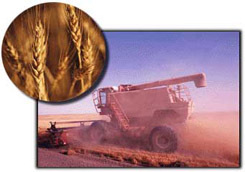
Climate Factors
Several factors directly connect climate change and agricultural productivity:
- Average temperature increase
- Change in rainfall amount and patterns
- Rising atmospheric concentrations of CO2
- Pollution levels such as tropospheric ozone
- Change in climatic variability and extreme events
Most agricultural impact studies have considered the effects of one or two aspects of climate change on a particular farming activity. Few, however, have considered the full set of anticipated shifts and their impact on agricultural production across the country.
Average temperature increase: An increase in average temperature can 1) lengthen the growing season in regions with a relatively cool spring and fall; 2) adversely affect crops in regions where summer heat already limits production; 3) increase soil evaporation rates, and 4) increase the chances of severe droughts.
Change in rainfall amount and patterns: Changes in rainfall can affect soil erosion rates and soil moisture, both of which are important for crop yields. The Intergovernmental Panel on Climate Change (IPCC) predicts that precipitation will increase in high latitudes, and decrease in most subtropical land regions-some by as much as about 20 percent. While regional precipitation will vary the number of extreme precipitation events is predicted to increase (IPCC, 2007).
Rising atmospheric concentrations of CO2: Increasing atmospheric CO2 levels, driven by emissions from human activities, can act as a fertilizer and enhance the growth of some crops such as wheat, rice and soybeans. CO2 can be one of a number of limiting factors that, when increased, can enhance crop growth. Other limiting factors include water and nutrient availability. While it is expected that CO2 fertilization will have a positive impact on some crops, other aspects of climate change (e.g., temperature and precipitation changes) may temper any beneficial CO2 fertilization effect (IPCC, 2007).
Pollution levels such as tropospheric ozone: Higher levels of ground level ozone limit the growth of crops. Since ozone levels in the lower atmosphere are shaped by both emissions and temperature, climate change will most likely increase ozone concentrations. Such changes may offset any beneficial yield effects that result from elevated CO2 levels.
Change in climatic variability and extreme events: Changes in the frequency and severity of heat waves, drought, floods and hurricanes, remain a key uncertainty in future climate change. Such changes are anticipated by global climate models, but regional changes and the potential affects on agriculture are more difficult to forecast.
 Print
Print Email
Email







